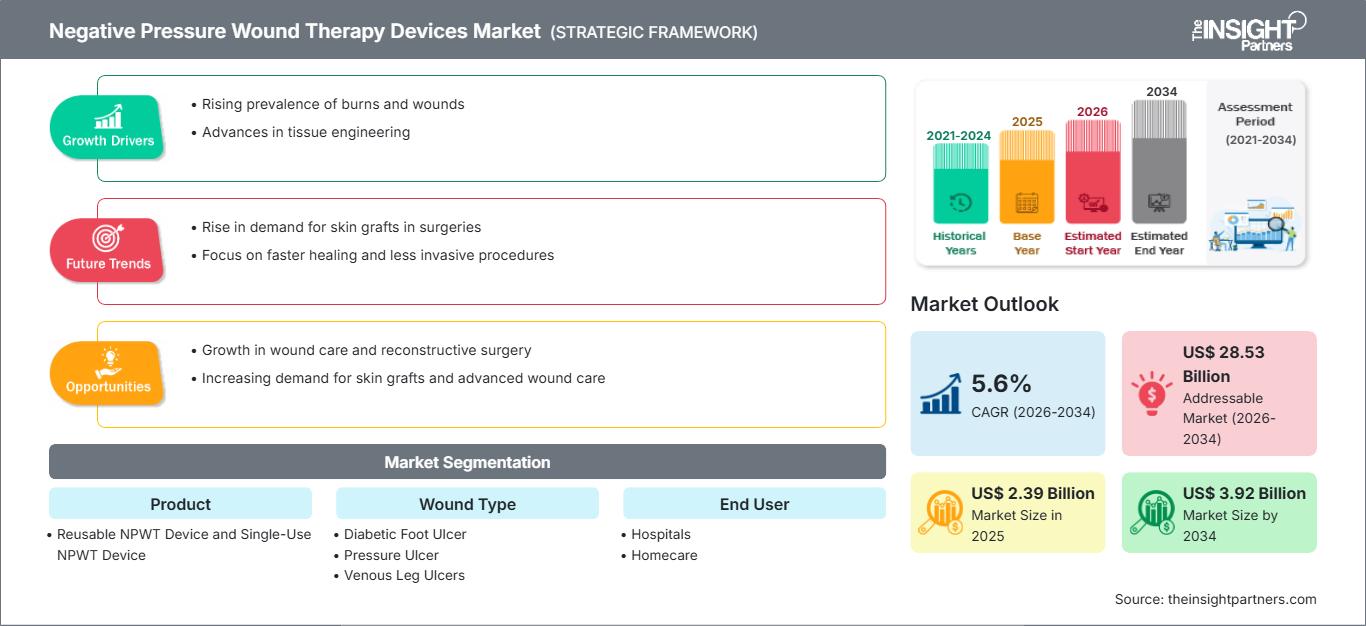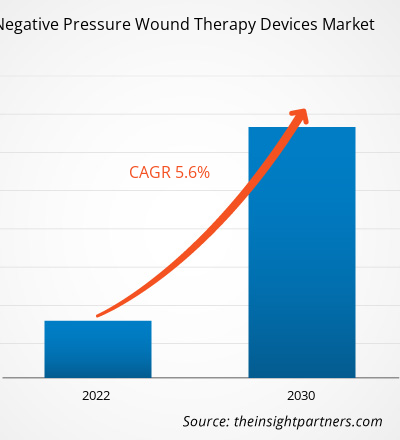Der Markt für Unterdruck-Wundtherapiegeräte, der 2025 einen Wert von 2,39 Milliarden US-Dollar erreichte, wird Prognosen zufolge bis 2034 auf 3,92 Milliarden US-Dollar anwachsen, was einem durchschnittlichen jährlichen Wachstum von 5,6 % im Zeitraum 2026–2034 entspricht. Die Marktbedingungen entwickeln sich stetig weiter und eröffnen den Akteuren neue Chancen. Insgesamt zeichnet sich der Markt durch stabile Fortschritte und langfristiges Wachstumspotenzial aus.
Der Einsatz vereinfachter Einweg-NPWT-Geräte hat deutlich zugenommen. Diese Entwicklung unterstreicht die Vorteile der Verfügbarkeit von NPWT-Geräten zu geringeren Kosten. Sie umfasst elektrisch und mechanisch betriebene Geräte. Einweggeräte werden aufgrund ihrer geringeren Komplikationsrate – wie Wunddehiszenz oder Infektion bei Anwendung auf geschlossenen chirurgischen Inzisionen – bevorzugt. Verglichen mit den ursprünglichen Plänen für die Geräte bei ihrer Einführung in die Klinik haben sich die Indikationen für die NPWT-Behandlung von Wunden aufgrund technologischer Fortschritte bereits erweitert. So können beispielsweise neue Wundarten (kleine, chirurgische Wunden) nun auch in neuen Umgebungen (z. B. in der Kurzzeitpflege zu Hause) behandelt werden, da kleinere Einwegpumpen verfügbar sind. Darüber hinaus könnten die bereits erwähnten, in Entwicklung befindlichen neuen Interventionen die verbesserte Akzeptanz potenziell weiter fördern.
Wachstumstreiber:
Günstige Erstattungspolitiken treiben das Marktwachstum für Unterdruck-Wundtherapiegeräte an
Ein Vorteil der Kostenerstattung für Unterdruck-Wundtherapie (NPWT) besteht darin, dass sie die moderne Wundversorgung zugänglicher macht. Diese erfolgreiche Behandlungsmethode für Patienten mit komplexen Wunden wird gefördert, wenn Gesundheitsdienstleister die Kosten für NPWT-Geräte erstattet bekommen. Der Einsatz von NPWT-Geräten kann Komplikationen bei chronischen Wunden vorbeugen und so zu besseren Behandlungsergebnissen, schnellerer Heilung und möglicherweise geringeren Gesamtkosten im Gesundheitswesen führen. Die Kostenerstattung motiviert Gesundheitseinrichtungen zur Anschaffung und Implementierung dieser Technologien, was sowohl für Patienten als auch für das Gesundheitssystem von Vorteil ist.
CPT |
|
|
97605 |
Unterdruck-Wundtherapie (z. B. Vakuum-gestützte Drainage) unter Verwendung von Hilfsmitteln, einschließlich topischer Applikation(en), Wundbeurteilung und Anweisungen für die weitere Pflege, pro Sitzung; Gesamtfläche der Wunde(n) kleiner oder gleich 50 Quadratzentimeter |
|
97606 |
Unterdruck-Wundtherapie (z. B. Vakuum-gestützte Drainage) unter Verwendung von Hilfsmitteln, einschließlich topischer Anwendung(en), Wundbeurteilung und Anweisungen für die weitere Pflege, pro Sitzung; Gesamtfläche der Wunde(n) größer als 50 Quadratzentimeter |
|
97607 |
Unterdruck-Wundtherapie (z. B. Vakuum-gestützte Drainage) unter Verwendung von Einweg-Medizinprodukten einschließlich Bereitstellung eines Exsudat-Auffangsystems, topischer Anwendung(en), Wundbeurteilung, Seite 6 von 7 Medicare MP192 und Anweisungen für die weitere Pflege, pro Sitzung; Gesamtfläche der Wunde(n) kleiner oder gleich 50 Quadratzentimeter |
|
97608 |
Unterdruck-Wundtherapie (z. B. Vakuum-gestützte Drainage) unter Verwendung von Einweg-Medizinprodukten einschließlich Bereitstellung eines Exsudat-Auffangsystems, topischer Anwendung(en), Wundbeurteilung und Anweisungen für die weitere Pflege pro Sitzung; Gesamtfläche der Wunde(n) größer als 50 Quadratzentimeter |
HCPCS |
|
|
A6550 |
Das Wundversorgungsset für die elektrische Unterdruck-Wundtherapie mit Pumpe enthält alle benötigten Materialien und Zubehörteile. |
|
A7000 |
Einwegkanister zur Verwendung mit einer Absaugpumpe, jeweils |
|
A9270 |
Nicht abgedeckter Artikel oder nicht abgedeckte Dienstleistung |
|
A9272 |
Wundabsaugung, Einweg, inklusive Verband, sämtlichem Zubehör und Komponenten, jeder Art, jedes |
|
E2402 |
Elektrische Unterdruck-Wundtherapiepumpe, stationär oder tragbar |
Quelle: Cardinal Health
Günstige Erstattungspolitiken fördern somit das Wachstum des Marktes für Unterdruck-Wundtherapiegeräte.
Passen Sie diesen Bericht Ihren Anforderungen an.
Sie erhalten eine kostenlose Anpassung aller Berichte – einschließlich Teilen dieses Berichts, Länderanalysen und Excel-Datenpaketen – sowie attraktive Angebote und Rabatte für Start-ups und Universitäten.
Markt für Unterdruck-Wundtherapiegeräte: Strategische Einblicke

-
Ermitteln Sie die wichtigsten Markttrends dieses Berichts.Diese KOSTENLOSE Probe beinhaltet eine Datenanalyse, die von Markttrends bis hin zu Schätzungen und Prognosen reicht.
Berichtssegmentierung und -umfang:
Die Marktanalyse für Geräte zur Unterdruck-Wundtherapie wurde unter Berücksichtigung der Produkt-, Wundart- und Endnutzersegmente durchgeführt.
Segmentanalyse:
Der Markt für Unterdruck-Wundtherapiegeräte ist nach Produktart in wiederverwendbare und Einweg-NPWT-Geräte unterteilt. Das Segment der wiederverwendbaren NPWT-Geräte hatte 2022 den größeren Marktanteil und wird voraussichtlich im Prognosezeitraum eine durchschnittliche jährliche Wachstumsrate (CAGR) von 5,8 % verzeichnen.
Wiederverwendbare Geräte sind wirtschaftlicher, da sie den ständigen Kauf von Einwegartikeln überflüssig machen, was wiederum das Wachstum dieses Segments fördert.
Der Markt für Unterdruck-Wundtherapiegeräte ist nach Wundart in diabetische Fußgeschwüre, Dekubitus, venöse Beingeschwüre und sonstige Wunden unterteilt. Das Segment Dekubitus hielt 2022 den größten Marktanteil und wird voraussichtlich im Prognosezeitraum die höchste durchschnittliche jährliche Wachstumsrate (CAGR) von 6,0 % verzeichnen.
Der Markt für Unterdruck-Wundtherapiegeräte ist nach Endnutzer in Krankenhäuser, häusliche Pflege und Sonstige unterteilt. Das Segment der Krankenhäuser hielt 2022 den größten Marktanteil und wird voraussichtlich im Prognosezeitraum die höchste durchschnittliche jährliche Wachstumsrate (CAGR) von 5,9 % verzeichnen.
Regionalanalyse:
Der Bericht zum globalen Markt für Unterdruck-Wundtherapiegeräte umfasst die Bewertung der Marktentwicklung in Nordamerika, Europa, Asien-Pazifik, Süd- und Mittelamerika sowie im Nahen Osten und Afrika. Nordamerika hielt 2022 den größten Marktanteil an Unterdruck-Wundtherapiegeräten. Die alternde Bevölkerung in Kanada führt zu einer Zunahme chronischer Wunden und damit zu einer steigenden Nachfrage nach innovativen Wundversorgungsprodukten wie NPWT-Geräten. Aufgrund der zunehmenden Verbreitung chronischer Erkrankungen wie Diabetes und Adipositas, die das Risiko chronischer Wunden erhöhen, besteht ein wachsender Bedarf an effizienten Wundbehandlungen. Der kanadische Markt für NPWT-Geräte ist aufgrund dieser Faktoren dynamisch und expandiert.
Zukunftschancen:
In Entwicklungsländern ist die hohe Prävalenz chronischer Wunden häufig zu beobachten. Gründe hierfür sind unter anderem die Zunahme ansteckender Krankheiten und eine unzureichende Gesundheitsinfrastruktur. Unterdruck-Wundtherapiegeräte (NPWT) können hier Abhilfe schaffen, da sie fortschrittliche Wundversorgungslösungen bieten. Laut einem Artikel der International Society for Pharmacoeconomics and Outcomes Research, Inc. (ISPOR) erleiden 15 % der Diabetiker in Indien im Laufe ihres Lebens ein diabetisches Fußgeschwür. Die steigende Nachfrage nach NPWT-Geräten in Entwicklungsländern dürfte daher im Prognosezeitraum erhebliche Wachstumschancen für den Markt für Unterdruck-Wundtherapiegeräte eröffnen.
Unterdruck-Wundtherapiegeräte
Markt für Unterdruck-Wundtherapiegeräte: Regionale Einblicke
Die regionalen Trends und Einflussfaktoren auf den Markt für Unterdruck-Wundtherapiegeräte im gesamten Prognosezeitraum wurden von den Analysten von The Insight Partners eingehend erläutert. Dieser Abschnitt behandelt außerdem die Marktsegmente und die geografische Verteilung des Marktes für Unterdruck-Wundtherapiegeräte in Nordamerika, Europa, Asien-Pazifik, dem Nahen Osten und Afrika sowie Süd- und Mittelamerika.
Marktbericht über Geräte zur Unterdruck-Wundtherapie: Umfang
| Berichtattribute | Details |
|---|---|
| Marktgröße im Jahr 2025 | 2,39 Milliarden US-Dollar |
| Marktgröße bis 2034 | 3,92 Milliarden US-Dollar |
| Globale durchschnittliche jährliche Wachstumsrate (2026 - 2034) | 5,6 % |
| Historische Daten | 2021-2024 |
| Prognosezeitraum | 2026–2034 |
| Abgedeckte Segmente |
Nebenprodukt
|
| Abgedeckte Regionen und Länder |
Nordamerika
|
| Marktführer und wichtige Unternehmensprofile |
|
Marktdichte der Akteure im Markt für Unterdruck-Wundtherapiegeräte: Auswirkungen auf die Geschäftsdynamik verstehen
Der Markt für Unterdruck-Wundtherapiegeräte wächst rasant, angetrieben durch die steigende Nachfrage der Endverbraucher. Gründe hierfür sind unter anderem sich wandelnde Verbraucherpräferenzen, technologische Fortschritte und ein wachsendes Bewusstsein für die Vorteile des Produkts. Mit steigender Nachfrage erweitern Unternehmen ihr Angebot, entwickeln innovative Lösungen für die Bedürfnisse der Verbraucher und nutzen neue Trends, was das Marktwachstum zusätzlich beflügelt.

- Überblick über die wichtigsten Akteure auf dem Markt für Unterdruck-Wundtherapiegeräte
Wettbewerbsumfeld und Schlüsselunternehmen:
Die Marktprognose für Geräte zur Unterdruck-Wundtherapie unterstützt die Akteure in diesem Markt bei der Planung ihrer Wachstumsstrategien. Zu den führenden Unternehmen, die im Marktbericht für Geräte zur Unterdruck-Wundtherapie vorgestellt werden, gehören 3M, Smith+Nephew, DeRoyal Industries, Inc., Nexa Medical Limited, Lion Street Medical, LLC (Pensar Medical LLC), ConvaTec Inc., Cardinal Health, Inc., Mölnlycke Health Care AB, PAUL HARTMANN und Medela AG. Diese Unternehmen konzentrieren sich auf die Entwicklung neuer Technologien, die Verbesserung bestehender Produkte und die Erweiterung ihrer geografischen Präsenz, um der weltweit steigenden Kundennachfrage gerecht zu werden.
- Historische Analyse (2 Jahre), Basisjahr, Prognose (7 Jahre) mit CAGR
- PEST- und SWOT-Analyse
- Marktgröße Wert/Volumen – Global, Regional, Land
- Branchen- und Wettbewerbslandschaft
- Excel-Datensatz
Aktuelle Berichte
Verwandte Berichte
Erfahrungsberichte
Grund zum Kauf
- Fundierte Entscheidungsfindung
- Marktdynamik verstehen
- Wettbewerbsanalyse
- Kundeneinblicke
- Marktprognosen
- Risikominimierung
- Strategische Planung
- Investitionsbegründung
- Identifizierung neuer Märkte
- Verbesserung von Marketingstrategien
- Steigerung der Betriebseffizienz
- Anpassung an regulatorische Trends






















 Kostenlose Probe anfordern für - Markt für Geräte zur Unterdruck-Wundtherapie
Kostenlose Probe anfordern für - Markt für Geräte zur Unterdruck-Wundtherapie